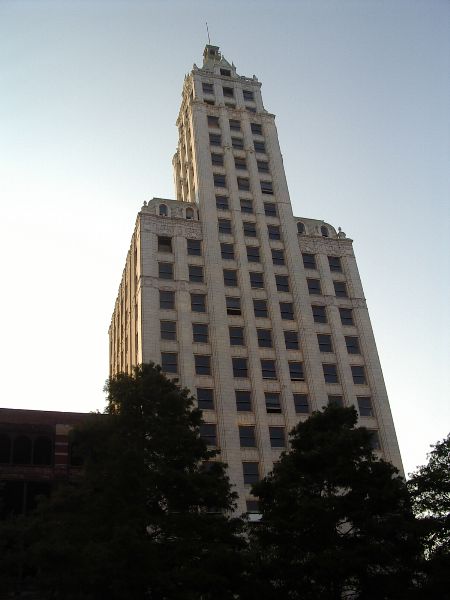|
Help About Related Share Your Story General Mall
Food Court Retail Entertainment Management Souvenirs Related Links
|
LincolnAmericanTower
Lincoln American Tower
The tower is a replica of New York's Woolworth Building, at one-third scale. The Lincoln American Tower is a 22 story building located at the corner of North Main and Court streets in Memphis, Tennessee. It is also a historical landmark, one of the first steel frame skyscrapers built in Memphis. The tower underwent a six year refurbishing project starting in 2002, and despite a fire in 2006, is now open and accepting tenants.  The building currently features 31 residential apartments, 3 floors of commercial offices, and New York-based Ceriello Fine Foods on the ground floor. The site itself has a unique history, as it is located near the location of Irving Block Prison, which was on the north side of Court Square, which was used by the Union Army to house Confederate sympathizers during the Civil War. Freeing prisoners from Irving Block Prison was one of the three major objectives of Maj. Gen. Nathan Bedford Forrest's raid in the Second Battle of Memphis. In 1924, the president of the Memphis branch of the Columbia Mutual Insurance Company (later renamed to the Lincoln American Insurance Company), Lloyd Binford, had the gleaming white tower built overlooking Court Square. Binford later made an infamous name for himself across the country as head of the Memphis Censor Board, which he ran from his own offices on the top floor of the building. The Lincoln American Tower was added to the National Register of Historic Places in 1978. On October 6, 2006, the building was damaged by fire after embers from a major fire at the nearby First United Methodist Church were carried several blocks by strong winds. The result lit the top few floors of the building on fire, including the roof, and filled much of downtown Memphis with smoke. The nearby Court Annex building was destroyed in the same fire. Despite the fire, the renovation of the building continued, and the first tenants in 2008 were the Plough Foundation, who leased 4,358 square feet (404.9 m2) of space in the building.
From the Memphis FlyerWith all the news about the Lincoln American Tower — one of four downtown buildings heavily damaged or destroyed in last week’s downtown blaze — so far nobody has mentioned the building’s most famous — some would say infamous — tenant. Lloyd T. Binford, president of the Memphis branch of the Columbia Mutual (later Lincoln American) Insurance Company, had the gleaming white tower built in 1925 overlooking Court Square. But insurance was just his day job; Binford made a name for himself here and across the country as head of the Memphis Censor Board, a job he held from 1928 to 1955. And what a censor he was. Because he had once been robbed while working as a mail clerk on a train, he forbade the showing of any westerns that featured train robberies. He hated Charlie Chaplin, calling him “that London Guttersnipe” and “a traitor to decency and virtue,” so refused to allow theaters here to show any Chaplin movies. Because Binford disapproved of Ingrid Bergman’s affair with Italian film director Roberto Rossellini, her films were blackballed too. After all, the actress “was living in open and notorious adultery.” He banned such classics as Rebel Without A Cause because, he claimed, it “promoted juvenile delinquency.” More troubling, though, was Binford’s attitude towards blacks. Though insisting he was not a racist, he made film distributors here actually cut out scenes from movies that showed blacks and whites on an equal footing — such as a classroom scene in Curley (1947), for example, that happened to show black and white children attending a school together. “The South does not recognize social equality between the races,” he explained. Lena Horne’s segment was snipped completely out of Ziegfield Follies (1946), and he banned Imitation of Life (1934) and Brewster’s Millions (1945) because “they gave too much prominence to negroes.” Binford made Memphis a laughing stock. National publications mocked our city, with Time magazine saying Binford had “been sniffing too many magnolias.” Movies he censored were called “Binfordized” and it’s a fact that Memphians saw films that were shorter than those shown in other cities, though they never realized what had been cut from them. Nevertheless, he ran the Memphis Censor Board with an iron fist for almost three decades. He died in 1957, and is buried in Elmwood, but his lasting monument in Memphis is the Lincoln American Tower, where he had offices on the top floor. ReferencesWikipedia Various Urban Exploration sites - not listed due to the secret nature of their efforts |





















